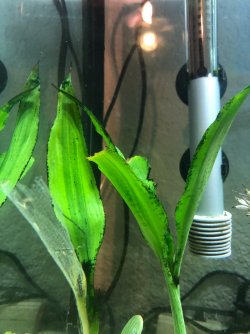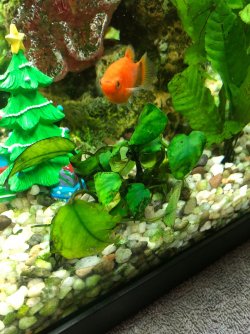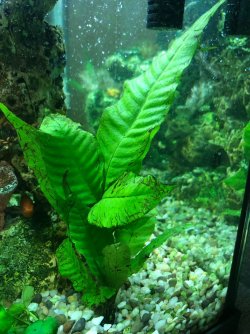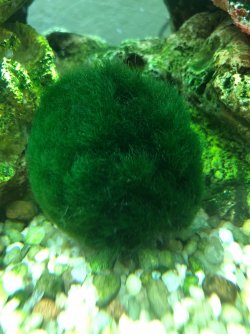Hello friends!
I got a 29 gal tank about 8 months ago now and with it I made a goal to myself that I wouldn't have, at any time, more plastic décor than I do living plants. I was thinking that if I was to keep fish, I wanted to make it as natural as possible. I started off with 2 Top Fin "Ribbon" plants and 2 small bush like plants (Cant remember the names or find online but they look like the anubias plant from top fin). Those grew for a while but started to die, I threw out one of the bush plants and one of the ribbons because they were pretty much dead and added a fern plant. I also bought 3 moss balls a while back, two of which just disappeared one day (If anyone has any idea what happened to them I would love to know) leaving me with one. Other than that, I have a large coral decoration in the middle that the algae eater likes to hide in and a little Christmas tree too. With all of that aside, I have a few main points. First, is it bad to have an all living plat aquarium? Should I put in some plastic ones to mix it up? Second, randomly one plant seems to just rapidly die all of a sudden, even though the other plants and fish are fine, anyone know why that is or how I could fix that/how can I help them to grow stronger/better? Third, every time I clean the tank with the vacuum, push the plants down into the gravel and put the top back on, the next day, they have all floated to the surface! Every time! I constantly have to rebury them just so I can have a few hours of a pretty tank before they all float away... how do I fix this? And finally, whenever the plants all float to the top and all tangle together in the corner, the fish like to just sit in them and swim through them, as if they are playing in the cover of the plants. That of course makes me think that they would like some grass like plants to play in and things like that. Any recommendations? I'm so sorry this thread is kind of all over the place and messy and if any clarifications are needed please ask! Any recommendations are so much help as i am very new to the whole live plant thing, thanks!
I got a 29 gal tank about 8 months ago now and with it I made a goal to myself that I wouldn't have, at any time, more plastic décor than I do living plants. I was thinking that if I was to keep fish, I wanted to make it as natural as possible. I started off with 2 Top Fin "Ribbon" plants and 2 small bush like plants (Cant remember the names or find online but they look like the anubias plant from top fin). Those grew for a while but started to die, I threw out one of the bush plants and one of the ribbons because they were pretty much dead and added a fern plant. I also bought 3 moss balls a while back, two of which just disappeared one day (If anyone has any idea what happened to them I would love to know) leaving me with one. Other than that, I have a large coral decoration in the middle that the algae eater likes to hide in and a little Christmas tree too. With all of that aside, I have a few main points. First, is it bad to have an all living plat aquarium? Should I put in some plastic ones to mix it up? Second, randomly one plant seems to just rapidly die all of a sudden, even though the other plants and fish are fine, anyone know why that is or how I could fix that/how can I help them to grow stronger/better? Third, every time I clean the tank with the vacuum, push the plants down into the gravel and put the top back on, the next day, they have all floated to the surface! Every time! I constantly have to rebury them just so I can have a few hours of a pretty tank before they all float away... how do I fix this? And finally, whenever the plants all float to the top and all tangle together in the corner, the fish like to just sit in them and swim through them, as if they are playing in the cover of the plants. That of course makes me think that they would like some grass like plants to play in and things like that. Any recommendations? I'm so sorry this thread is kind of all over the place and messy and if any clarifications are needed please ask! Any recommendations are so much help as i am very new to the whole live plant thing, thanks!







